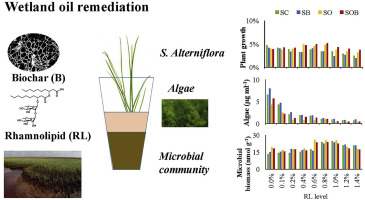当前位置:
X-MOL 学术
›
Chemosphere
›
论文详情
Our official English website, www.x-mol.net, welcomes your
feedback! (Note: you will need to create a separate account there.)
Potential use of biochar and rhamnolipid biosurfactant for remediation of crude oil-contaminated coastal wetland soil: Ecotoxicity assessment.
Chemosphere ( IF 8.1 ) Pub Date : 2020-04-06 , DOI: 10.1016/j.chemosphere.2020.126617 Zhuo Wei 1 , Jim J Wang 1 , Yili Meng 1 , Jiabing Li 2 , Lewis A Gaston 1 , Lisa M Fultz 1 , Ronald D DeLaune 3
Chemosphere ( IF 8.1 ) Pub Date : 2020-04-06 , DOI: 10.1016/j.chemosphere.2020.126617 Zhuo Wei 1 , Jim J Wang 1 , Yili Meng 1 , Jiabing Li 2 , Lewis A Gaston 1 , Lisa M Fultz 1 , Ronald D DeLaune 3
Affiliation

|
Remediation of wetland soils contaminated with petroleum hydrocarbons is a challenging task. Biosurfactant and biochar have been used in oil remediation. However, little is known about the ecotoxicity of these materials when applied in wetland ecosystems. In this study, the ecotoxicity of biochar and rhamnolipid (RL) biosurfactant as crude oil remediation strategies in a Louisiana wetland soil was investigated. A pot experiment was set up with wetland soil treated with/without crude oil followed by subjecting to application of 1% biochar and various levels of RL ranging from 0.1% to 1.4%. The ecotoxicity was evaluated regarding to high plant (S. Alterniflora), algae, and soil microbes. Specifically, after a 30-day growth in a controlled chamber, plant biomass change as well as shoot/root ratio was measured. Algae growth was estimated by quantifying chlorophyll by spectrometry following separation, and soil microbial community was characterized by phospholipid fatty acids analysis. Results showed that plant can tolerate RL level up to 0.8%, while algae growth was strongly inhibited at RL > 0.1%. Algal biomass was significantly increased by biochar, which offset the negative impact of oil and RL. Additionally, soil microbial community shift caused by crude oil and RL was alleviated by biochar with promoting Gram-positive bacteria, actinomycetes, and arbuscular mycorrhizal fungi. Overall, this study shows that integrated treatment of biochar and RL has the lowest ecotoxicity to plant and algae when used in oil remediation of contaminated wetland soils.
中文翻译:

生物炭和鼠李糖脂类生物表面活性剂在原油污染的沿海湿地土壤修复中的潜在用途:生态毒性评估。
修复被石油烃污染的湿地土壤是一项艰巨的任务。生物表面活性剂和生物炭已用于石油修复。但是,对于这些材料在湿地生态系统中的生态毒性了解甚少。在这项研究中,研究了生物炭和鼠李糖脂(RL)生物表面活性剂作为路易斯安那州湿地土壤中的原油修复策略的生态毒性。建立盆栽实验,用/不使用原油处理湿地土壤,然后施加1%的生物炭和0.1%至1.4%的各种RL。评价了对高植物(S. Alterniflora),藻类和土壤微生物的生态毒性。具体而言,在受控室内生长30天后,测量了植物生物量的变化以及枝/根比。分离后通过光谱法定量叶绿素来估计藻类的生长,并通过磷脂脂肪酸分析来表征土壤微生物群落。结果表明,植物可耐受RL的水平高达0.8%,而当RL> 0.1%时,藻类的生长受到强烈抑制。生物炭显着增加了藻类生物量,这抵消了石油和RL的负面影响。此外,生物炭通过促进革兰氏阳性菌,放线菌和丛枝菌根真菌,减轻了原油和RL引起的土壤微生物群落转移。总体而言,这项研究表明,生物炭和RL的综合处理用于污染的湿地土壤的油修复时,对植物和藻类的生态毒性最低。通过磷脂脂肪酸分析表征了土壤微生物群落。结果表明,植物可耐受RL的水平高达0.8%,而当RL> 0.1%时,藻类的生长受到强烈抑制。生物炭显着增加了藻类生物量,这抵消了石油和RL的负面影响。此外,生物炭通过促进革兰氏阳性菌,放线菌和丛枝菌根真菌,减轻了原油和RL引起的土壤微生物群落转移。总体而言,这项研究表明,生物炭和RL的综合处理用于污染的湿地土壤的油修复时,对植物和藻类的生态毒性最低。通过磷脂脂肪酸分析表征了土壤微生物群落。结果表明,植物可耐受RL的水平高达0.8%,而当RL> 0.1%时,藻类的生长受到强烈抑制。生物炭显着增加了藻类生物量,这抵消了石油和RL的负面影响。此外,生物炭通过促进革兰氏阳性菌,放线菌和丛枝菌根真菌,减轻了原油和RL引起的土壤微生物群落转移。总体而言,这项研究表明,生物炭和RL的综合处理用于污染的湿地土壤的油修复时,对植物和藻类的生态毒性最低。生物炭显着增加了藻类生物量,这抵消了石油和RL的负面影响。此外,生物炭通过促进革兰氏阳性菌,放线菌和丛枝菌根真菌,减轻了原油和RL引起的土壤微生物群落转移。总体而言,这项研究表明,生物炭和RL的综合处理用于污染的湿地土壤的油修复时,对植物和藻类的生态毒性最低。生物炭显着增加了藻类生物量,这抵消了石油和RL的负面影响。此外,生物炭通过促进革兰氏阳性菌,放线菌和丛枝菌根真菌,减轻了原油和RL引起的土壤微生物群落转移。总体而言,这项研究表明,生物炭和RL的综合处理用于污染的湿地土壤的油修复时,对植物和藻类的生态毒性最低。
更新日期:2020-04-06
中文翻译:

生物炭和鼠李糖脂类生物表面活性剂在原油污染的沿海湿地土壤修复中的潜在用途:生态毒性评估。
修复被石油烃污染的湿地土壤是一项艰巨的任务。生物表面活性剂和生物炭已用于石油修复。但是,对于这些材料在湿地生态系统中的生态毒性了解甚少。在这项研究中,研究了生物炭和鼠李糖脂(RL)生物表面活性剂作为路易斯安那州湿地土壤中的原油修复策略的生态毒性。建立盆栽实验,用/不使用原油处理湿地土壤,然后施加1%的生物炭和0.1%至1.4%的各种RL。评价了对高植物(S. Alterniflora),藻类和土壤微生物的生态毒性。具体而言,在受控室内生长30天后,测量了植物生物量的变化以及枝/根比。分离后通过光谱法定量叶绿素来估计藻类的生长,并通过磷脂脂肪酸分析来表征土壤微生物群落。结果表明,植物可耐受RL的水平高达0.8%,而当RL> 0.1%时,藻类的生长受到强烈抑制。生物炭显着增加了藻类生物量,这抵消了石油和RL的负面影响。此外,生物炭通过促进革兰氏阳性菌,放线菌和丛枝菌根真菌,减轻了原油和RL引起的土壤微生物群落转移。总体而言,这项研究表明,生物炭和RL的综合处理用于污染的湿地土壤的油修复时,对植物和藻类的生态毒性最低。通过磷脂脂肪酸分析表征了土壤微生物群落。结果表明,植物可耐受RL的水平高达0.8%,而当RL> 0.1%时,藻类的生长受到强烈抑制。生物炭显着增加了藻类生物量,这抵消了石油和RL的负面影响。此外,生物炭通过促进革兰氏阳性菌,放线菌和丛枝菌根真菌,减轻了原油和RL引起的土壤微生物群落转移。总体而言,这项研究表明,生物炭和RL的综合处理用于污染的湿地土壤的油修复时,对植物和藻类的生态毒性最低。通过磷脂脂肪酸分析表征了土壤微生物群落。结果表明,植物可耐受RL的水平高达0.8%,而当RL> 0.1%时,藻类的生长受到强烈抑制。生物炭显着增加了藻类生物量,这抵消了石油和RL的负面影响。此外,生物炭通过促进革兰氏阳性菌,放线菌和丛枝菌根真菌,减轻了原油和RL引起的土壤微生物群落转移。总体而言,这项研究表明,生物炭和RL的综合处理用于污染的湿地土壤的油修复时,对植物和藻类的生态毒性最低。生物炭显着增加了藻类生物量,这抵消了石油和RL的负面影响。此外,生物炭通过促进革兰氏阳性菌,放线菌和丛枝菌根真菌,减轻了原油和RL引起的土壤微生物群落转移。总体而言,这项研究表明,生物炭和RL的综合处理用于污染的湿地土壤的油修复时,对植物和藻类的生态毒性最低。生物炭显着增加了藻类生物量,这抵消了石油和RL的负面影响。此外,生物炭通过促进革兰氏阳性菌,放线菌和丛枝菌根真菌,减轻了原油和RL引起的土壤微生物群落转移。总体而言,这项研究表明,生物炭和RL的综合处理用于污染的湿地土壤的油修复时,对植物和藻类的生态毒性最低。











































 京公网安备 11010802027423号
京公网安备 11010802027423号